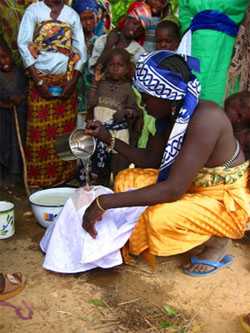Behavior Change Communications
The final component of the Safe Water System – behavior change communications to promote handwashing, sanitation, and safe food and water handling – is crucial to ensure the sustainability of the Safe Water System and maximize health impact.
Regular handwashing, improved sanitation and hygiene, and safe food and water handling practices help prevent contamination of treated, safely stored drinking water and reduce the risk of waterborne, foodborne, and person-to-person transmission of diarrheal and other diseases. For many individuals and communities using the Safe Water System for the first time, these behaviors are new and unfamiliar.
Teaching healthy behaviors and promoting their adoption requires education and reinforcement. Common techniques used to encourage behavior change include social marketing and community mobilization.
Social Marketing

Demonstrating filtration to community members
Social marketing is the practice of applying marketing techniques to achieve specific behavioral goals for a social good. It involves identifying the target audience, describing the benefits that will be offered by the new behavior, and creating interventions to influence or support the desired behavior change.
Social marketing techniques have been used successfully by Population Services International (PSI) and CDC to implement the Safe Water System (SWS) in over 20 countries. As a result of this effort, over 125 million bottles of hypochlorite solution — enough to treat approximately 118.7 billion liters of water — have been sold by PSI programs in over 20 countries since 1998 (through 2013).
CARE Kenya also used a combined social marketing/community mobilization approach to successfully implement the SWS in western Kenya [PDF – 1 page], Kenyan clinics [PDF – 1 page], Kenyan schools [PDF – 1 page], and in Madagascar.
For more information on social marketing, visit CDC’s Health Communication and Social Marketing Practice page.
Community Mobilization
Community mobilization refers to the use of community participation to address common, community-wide problems. During community mobilization, the community is involved in all phases of problem solving, from the selection and implementation of the intervention to the monitoring of its success.
Community Mobilization in Practice
SWS in Madagascar
In Madagascar, CARE used community mobilization as part of a Safe Water System (SWS) social marketing campaign for some community members, while other community members were exposed to the SWS social marketing campaign without the community mobilization piece. Results from the program showed that the households exposed to the social marketing campaign that also involved community mobilization adopted the SWS behaviors at twice the rate of the households that were exposed to the social marketing alone 1.
SWS in Kenya
CARE Kenya used community mobilization combined with social marketing in a field trial [PDF – 1 page] of the SWS in rural Kenyan communities. Program results showed that over a third of the target population adopted the SWS disinfectant solution in less than 6 months 2. A health impact study on the same population also revealed that children under the age of 5 who were living in households using the SWS had a 58% lower risk of diarrheal illness than children living in households not using the SWS 3.
References
- Dunston C, McAfee D, Kaiser R, Rakotoarison D, Rambeloson L, Hoang AT, Quick RE. Collaboration, cholera, and cyclones: a project to improve point-of-use water quality in Madagascar. Am J Public Health. 2001;Oct 91(10):1574-6.
- Makutsa P, Nzaku K, Ogutu P, Barasa P, Ombeki S, Mwaki A, Quick RE. Challenges in implementing a point-of-use water quality intervention in rural Kenya. Am J Public Health. 2001;Oct 91(10):1571-73.
- Garrett V, Ogutu P, Mabonga P, Ombeki S, Mwaki A, Aluoch G, Phelan M, Quick RE. Diarrhoea prevention in a high-risk rural Kenyan population through point-of-use chlorination, safe water storage, sanitation, and rainwater harvesting. Epidemiol Infect. 2008;Nov 136(11):1463-71.
Additional Resources
For more information about behavior change communications, visit:
- Page last reviewed: April 23, 2014
- Page last updated: April 23, 2014
- Content Source:


 ShareCompartir
ShareCompartir